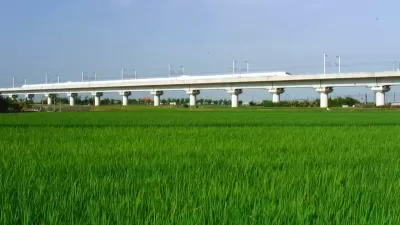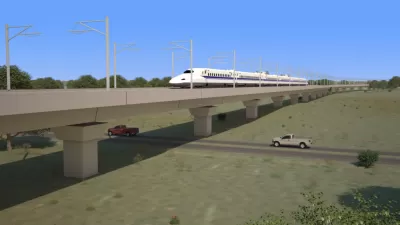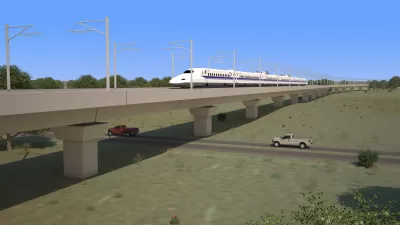Carlos Aguilar, Texas Central president and CEO, comments on the changes to the San Francisco-to-Anaheim project announced last month by California Gov. Gavin Newsom, and why his project linking Houston and Dallas/Fort Worth will progress.

"We fully understand the complexities of the California High-Speed Rail (HSR) project and the drivers that have led to the Governor of California’s decision to limit the scope of that state’s HSR," writes Carlos Aguilar, a former senior vice president at the global engineering company CH2M Hill.
It is important to contrast both the physical facts that make our project different, as well as the government versus private approach to building such large-scale infrastructure.
Topographical challenges in California non-existent in Texas
"The main challenge ... is connecting the Central Valley to the main centers of population in the Bay Area and Los Angeles," continues Aguilar.
This is why the current range of expected cost in California is between $77 billion and $98 billion. Out of this figure, the tunnels required to link the valley to San Jose (Pacheco Pass) and Los Angeles (Tehachapi Mountains) collectively, could cost well over $20 billion with significant underground risk.
To put this in perspective, the potential cost of these tunnels alone, is more than the total projected cost of Texas Central’s 240-mile project to link Houston and North Texas.
According to Texas Central, "the train system will cost more than $12-billion to construct. This includes the tracks, viaducts, berms, maintenance facilities, power substations, and three passenger stations."
Texas bullet train will remove cars from Interstate 45
The trip from Dallas to Houston, with one intermediary stop in the Brazos Valley, will take only 90 minutes, much faster than an auto trip today, let alone the future.
"Nearly 50,000 Texans travel between the two metropolitan areas at least once a week, 90% of them by car," writes Keith Barrow for Railway Age.
The current journey time by road ranges from 3.5 to 5.5 hours, and traffic has increased nearly 10% annually since 2012. A Texas Department of Transportation study estimates journey times could reach 6.5 hours by 2035, even with the additional capacity provided by planned highway enhancements.
Why Texas?
To paraphrase James Carville, "it's the jobs, stupid."
"After reviewing over 90 pairs of cities to determine the most commercially successful place to deploy a high-speed train, Houston to Dallas was the answer," writes Aguilar.
The Houston to Dallas/Fort Worth region is by far, the most rapidly growing region in the nation. In 2018, Dallas and Houston combined added 224,700 jobs, compared to number two city, New York, at 115,500 jobs. No other region even comes close.
At the right distance, with the right economic links between Dallas, Houston and the Brazos Valley, and without the complexities now evident in California, our approach is more financially feasible.
Private, not public approach to financing
The California project was launched in 2008 with a nearly $10 billion bond measure, and has received federal funding of $3.5 billion that President Trump, in light of Newsom's Feb. 12 announcement, wants to recoup. Additional funding has come from the state's cap-and-trade program.
In contrast, the Texas high-speed rail train is funded by "investors and entrepreneurs," according to the FAQ.
Texas Central is an investor-funded company utilizing a market-led approach to financing, led by a group of primarily Texan investors. The Railroad will not seek grants from the US Government or the State of Texas, nor any operational subsidy once operation begins. The project will be financed with a blend of debt and equity.
"We are confident the Texas line will provide the ridership to sustain the operations, repay the debt and provide a return to the investors," concludes Aguilar.
Construction is scheduled to start late this year.
FULL STORY: The Difference in the Texas and California HSR projects

Study: Maui’s Plan to Convert Vacation Rentals to Long-Term Housing Could Cause Nearly $1 Billion Economic Loss
The plan would reduce visitor accommodation by 25,% resulting in 1,900 jobs lost.

North Texas Transit Leaders Tout Benefits of TOD for Growing Region
At a summit focused on transit-oriented development, policymakers discussed how North Texas’ expanded light rail system can serve as a tool for economic growth.

Why Should We Subsidize Public Transportation?
Many public transit agencies face financial stress due to rising costs, declining fare revenue, and declining subsidies. Transit advocates must provide a strong business case for increasing public transit funding.

Alabama: Trump Terminates Settlements for Black Communities Harmed By Raw Sewage
Trump deemed the landmark civil rights agreement “illegal DEI and environmental justice policy.”

Dear Tesla Driver: “It’s not You, It’s Him.”
Amidst a booming bumper sticker industry, one writer offers solace to those asking, “Does this car make me look fascist?”

A Visual Celebration of Manhattan’s Chinatown Elder Community, Through Food
Lanterns, cafeteria trays, and community connection take center stage in this stunning photo essay.
Urban Design for Planners 1: Software Tools
This six-course series explores essential urban design concepts using open source software and equips planners with the tools they need to participate fully in the urban design process.
Planning for Universal Design
Learn the tools for implementing Universal Design in planning regulations.
City of Santa Clarita
Ascent Environmental
Institute for Housing and Urban Development Studies (IHS)
City of Grandview
Harvard GSD Executive Education
Toledo-Lucas County Plan Commissions
Salt Lake City
NYU Wagner Graduate School of Public Service




























